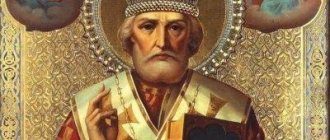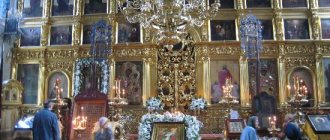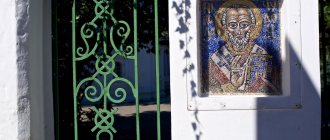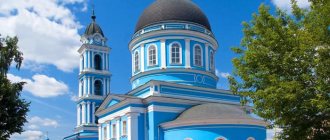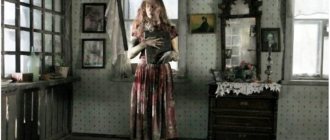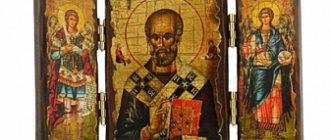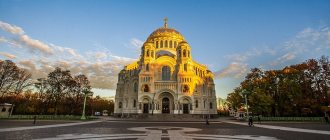| St. Petersburg St. Nicholas Naval Cathedral, beginning. 2010s |
St. Petersburg St. Nicholas Naval Cathedral
of the St. Petersburg Diocese
- Thrones: Epiphany (upper temple); St. St. Nicholas the Wonderworker (lower middle); Beheading of Saint John the Baptist (lower right); svtt. Demetrius of Rostov and Theodosius of Chernigov (lower left)
- Address: Russia, 190068, St. Petersburg, Nikolskaya square, 1/3
- Tel. (abbot); 714-69-26 (altar); 714-08-62 (candle box); 714-70-85 (administration building, 24/7); 713-61-44 (fax)
- Official site:
- On the map: Yandex.Map, Google map
The history of the cathedral and its shrines is inextricably linked with the history and traditions of the Russian Navy.
What makes it especially valuable is the fact that the temple has preserved to this day its historical appearance and interiors as they were seen by kings, bishops and laymen for more than 200 years. From June 1941 to 1991 it was the cathedral of the St. Petersburg diocese.
Chapel, linen and wooden churches
At first, the life of St. Petersburg centered around the main shipyard - the Admiralty. Behind the esplanade of the Admiralty was the Morskaya Settlement, where many people settled who worked on the birth of a powerful fleet. For the spiritual nourishment of officers and employees of the Naval Department, several churches were built near the Admiralty. In 1710, a small wooden church was built on the Admiralty Meadow in the name of St. Isaac of Dalmatia, which was under the jurisdiction of the Admiralty Board. A little later it was rebuilt in stone. In 1730, this temple came under the jurisdiction of the Spiritual Board, and the parish was assigned to a small chapel located in the Morskaya Sloboda in the “svetlitsa” of the regimental courtyard. It was consecrated in honor of the heavenly patron of sailors - St. Nicholas the Wonderworker. This chapel was the only one in the vast space behind the Moika and therefore was distinguished by its rich decoration.
In 1733, instead of a chapel, a linen church was built in the name of the same saint.
In 1743 it was replaced by a separate wooden church. The church's congregation was significant: 3,384 naval employees, not counting wives and children. To the west of the church there was a naval cemetery. The wooden church existed until the beginning of 1761.
Construction of a stone temple
| St. Petersburg St. Nicholas Naval Cathedral, beginning. 1910s Source: “Petersburg through a century.” Photographer K. Bulla. Photo from oldsp.ru |
In the spring of 1752, the President of the Admiralty Collegium, Admiral General Prince Mikhail Mikhailovich Golitsyn, submitted a petition to Empress Elizabeth Petrovna: “In reward of the worthy memory of the glorious deeds of the Russian Navy...” at the expense of the Naval Department and voluntary donations, to erect a stone church in the city of St. Peter in honor of the patron saint of sailors - Saint Nicholas the Wonderworker.
On June 16, Empress Elizaveta Petrovna signed a decree on the construction of a new stone church to replace the dilapidated wooden St. Nicholas Church. The development of the project for the new temple was entrusted to the architect of the Admiralty College, Savva Ivanovich Chevakinsky. Money for the construction was ordered to be allocated from the “bridge funds”, but it turned out to be insufficient, so the rest was taken from the Admiralty funds. All church utensils were also purchased by the Admiralty College. The first project for the cathedral was submitted by Savva Ivanovich in May 1752. Initially, it was planned to be much smaller than the current one, but frequent floods forced changes to be made so that the cathedral would not suffer from excess water. It was decided to raise the cathedral so that during floods the floor would not be covered with water. This forced us to change the dimensions of the building in order to maintain symmetry and proportions.
The modified project was approved, and on June 15, 1753, by order of Elizabeth Petrovna, Archbishop of St. Petersburg Sylvester (Kulyabka) laid the foundation stone for the church.
By 1756, work began on the exterior decoration of the temple. Difficulties were caused by the production of metal structures for the chapters. To order them, the architect personally went to Tula to see the owner of the ironworks, P. A. Demidov, who provided all possible support for this matter.
By the autumn of 1760, crosses were erected on the temple.
In 1755, when the walls of the cathedral were just being roofed, work on interior decoration began in advance.
Simultaneously with the construction of the cathedral, a bell tower was being built nearby. The location for it was chosen to the west of the cathedral. Work began in 1756, and by 1758 the bell tower was completed and plastered. At the same time, the bells were raised and the clock with chimes was installed. By that time, the bell tower of St. Nicholas Cathedral had one of the best sets of bells in St. Petersburg.
| Obelisk in memory of the crew of the battleship "Emperor Alexander III", who died in the Battle of Tsushima in the park of the St. Nicholas Naval Cathedral, 1908 (?) Photo by K.K. Bulls, from the site oldsp.ru |
The lower church in the name of St. Nicholas was consecrated by Archbishop Sylvester on December 5, 1760, on the eve of the temple feast.
On the same day, the right aisle of the lower church was consecrated in honor of the Beheading of St. John the Baptist. On July 20, 1762, Archbishop Benjamin of St. Petersburg, in the presence of Empress Catherine II, consecrated the upper church in honor of the Epiphany and the lower left chapel in honor of the newly glorified St. Demetrius of Rostov. At the same time, the Empress “orally commanded” the newly consecrated church to be called the Naval Cathedral
. From that time on, the victories of the Russian fleet began to be celebrated in St. Nicholas Naval Cathedral.
Since then, the temple has changed only slightly. In 1845, the gates of the main boundary of the lower temple were replaced, due to the fact that the previous ones had become dilapidated and the carvings were already difficult to hold on to them. The new gate was made according to the same design, but slightly smaller than the previous one.
In 1862, the wooden stairs leading to the upper temple were replaced with stone ones.
In 1870, the Society for the Welfare of the Parish Poor was founded at the cathedral.
After the temple was transferred to the Naval Department in 1901, stoves were installed in the upper temple, and it became warm.
On May 14, 1908, the grand opening of a monument in memory of the heroes of the Russian-Japanese War took place in the park of the Naval Cathedral.
In 1913, the head of the cathedral, merchant of the 1st guild Alexei Ivanovich Ivanov, made a new throne and altar: metal, gilded, chased and sculpted, with artistic painting in medallions.
Cathedral during the years of persecution
The October Revolution and the coming to power of the Bolsheviks immediately affected the position of the cathedral. Within a few months his status changed. On April 6, 1918, St. Nicholas Cathedral became a parish cathedral.
All cathedral property and capital, according to the decrees of the Soviet government, were subject to nationalization. In May 1919, the Petrograd Department of Justice, threatening members of the clergy with court, demanded that all bank documents be presented. According to the inventory, capital in the amount of 147,392 rubles was transferred to the treasury. Soon it came to church property. A complete inventory was compiled. At a meeting of parishioners, an agreement was signed with a representative of the district executive committee on the official transfer of the cathedral with all its equipment “for free and indefinite” use to a group of believers.
During its existence, the St. Nicholas Naval Cathedral accumulated the richest values. In April 1922, during a campaign to confiscate church valuables, several dozen items of church utensils, weighing a total of 328 kilograms, were confiscated from the cathedral. Some of the shrines were bought by parishioners, who contributed an equal amount of silver. None of the members of the clergy at this time were arrested or convicted.
The cathedral was one of the first centers of the fight against the renovationists. At a meeting of the cathedral parishioners on July 23, 1922, a decision was made to form Petrograd autocephaly. A report was heard from the rector, Archpriest Alexander Belyaev, on the history of the Higher Church Administration and the Petrograd Diocesan Administration. At the end of the report, the rector pointed out that, on the basis of the decree on freedom of conscience and other regulations, each parish community has the right to independent existence, and no other organization can dispose of it without its will. This view was expressed in the resolution.
Such resistance was met negatively by the authorities. At the head of the Petrograd autocephaly was Bishop Alexy (Simansky), the future Patriarch, and Nikolai (Yarushevich), the governor of the Alexander Nevsky Lavra. The authorities traditionally began to undertake repression to combat this movement. On October 26, a group of priests was exiled to Central Asia for 3 years, and Bishop Alexy (Simansky) of Yamburg was exiled to Kazakhstan. Bishop Nikolai (Yarushevich) of Peterhof became the head of the resistance movement. In a short period of time, the number of parishes that broke with the Renovationists increased to 65. During this period, Bishop Nicholas very often performed divine services in the cathedral. In 1923, he, as well as the rector of the cathedral, Archpriest Alexander Belyaev, were arrested and deported.
Archpriest Nikolai Rusanov was appointed rector of the Epiphany Cathedral, and the temple was captured by the renovationists for several months. On July 22, 1923, renovationist priests were expelled from the cathedral. However, repressions soon struck again and the renovationists took advantage of this. In September, Archpriest N.N. again became rector. Rusanov.
Unique valuables were confiscated from the temple: Gospels in silver frames, icons, silver frames, a set of silver vessels. The lower temple was not heated, which led to dampness.
In January 1924, the temple again returned under the omophorion of Patriarch Tikhon, and in March, Archpriest Nikolai Kirillovich Chukov, the future Metropolitan of Leningrad Gregory, became the rector of the temple. Through his efforts, not only the cathedral was restored, but also the bell tower. On November 23, the celebration of the “renewal of the temple” took place.
The confiscation of valuables belonging to St. Nicholas Cathedral continued. In addition, attempts to steal from the temple have become more frequent. Measures were taken against this with additional duty, however, thefts could not be completely avoided. At the same time, Orthodox churches were closed everywhere and the cathedral more than once had to accept the remaining icons and shrines.
On July 9, 1934, 13 bells with a total weight of 20,408 kilograms were removed from the bell tower of St. Nicholas Cathedral. At the same time, the confiscation of church valuables continued and the arrests of clergy did not stop.
By the early 1940s, the wave of persecution began to subside a little, but the vast majority of churches had already been closed. By 1941, the Leningrad diocese consisted of 21 active Orthodox churches, of which 8 were in Leningrad itself. The number of surviving clergy did not exceed 20 people, of which five served in the St. Nicholas Cathedral.
The cathedral in the second half of the 20th century
| St. Nicholas Cathedral of the Epiphany in Leningrad. Disguise. Photo 1941-1942, photographer S.N. Davydov, from the site oldsp.ru |
In June 1941, the St. Nicholas Cathedral became a cathedral.
For almost the entire period of the Great Patriotic War, right up to the moment of his accession to the patriarchal throne, Metropolitan Alexy (Simansky) lived and served here. On his initiative, the collection of donations from believers for the defense fund began on June 23. The community of St. Nicholas Cathedral contributed 355 thousand rubles in the first months of the war, and by the beginning of 1942 - another 60 thousand. The total amount of contributions from the St. Nicholas Cathedral during the Great Patriotic War amounted to 4,703,598 rubles. This amount was equal to 30% of all contributions from the Leningrad diocese, and not a single church of the Russian Orthodox Church, with the exception of the Elokhov Cathedral in Moscow, contributed more.
In August 1941, camouflage of the domes began using covers, nets and camouflage painting. But painting was rarely used so as not to damage the gilding. The work was completed by September 1942.
With the onset of the blockade, services in the cathedral were held daily from 8 to 10 o'clock and from 16 to 18 o'clock. Responsible air defense duty officers were appointed from among the parishioners to guard the temple. At first, when the alarm sounded, the worshipers went to bomb shelters, but then they got used to it and the services were often not interrupted. During the days of the siege, Vladyka Alexy served the Divine Liturgy alone without a deacon, read the commemorations himself and every evening served a prayer service to St. Nicholas, and then walked around the St. Nicholas Cathedral with the icon of the Pleasant, praying to Him to save the temple and the city from destruction.
Before the relics of St. Theodosius of Chernigov were returned to Chernigov in 1946, they were kept for several months in a shrine in the St. Nicholas Naval Cathedral, where a particle of his relics has remained since then [1]. During the war, the cathedral was seriously damaged by shelling and bombing, and was finally restored only in 1953. Probably during this period, the lower left chapel of St. Demetrius of Rostov was reconsecrated in the name of two saints - Demetrius of Rostov and Theodosius of Chernigov. In the 1940-1950s, the number of parishioners of the temple grew steadily.
In the autumn of 1958, the so-called “Khrushchev persecutions” began. The diocesan clergy was purged and the most uncompromising priests were expelled, including several from the St. Nicholas Cathedral. The life of the cathedral during this period is described in detail by the report of the rector, Archpriest Alexander Medvedsky [2] to the Leningrad Commissioner of the Council for the Affairs of the Russian Orthodox Church G.S. Zharinov dated November 19, 1963. The report says that services are conducted without undue pomp, although in accordance with established traditions. The number of akathists has been reduced, and liturgies on Sundays are performed not by a conciliar, but by one priest due to the lack of clergy. Preaching is also shortened, and does not even always take place on Sundays, because sermons must be submitted for verification, which requires time. The overwhelming number of parishioners were elderly women over the age of 45, men made up no more than 10%, and there were not even 1% of young people.
In 1970 - 1980, the activities of the cathedral did not go beyond the scope of liturgical life. Church life in Leningrad intensified only on the eve of the celebration of the millennium of the Baptism of Rus' in 1988. In St. Nicholas Cathedral, several dozen people were baptized every day, and the number of parishioners increased significantly. The clergy received the opportunity to carry out spiritual, educational, missionary and charitable activities.
Modern life of the cathedral
| St. Petersburg St. Nicholas Naval Cathedral, beginning. XXI century |
The cathedral is open daily from 6.30 to 22.00.
On Saturdays and Sundays, classes are regularly held to study the Sacred History of the Old and New Testaments for children and adults in the upper church of the cathedral.
During classes with adults, attention is paid to the inner life of the Church and the St. Petersburg diocese, and explanatory work is also carried out about the harm caused to the human soul and heart by psychics and other modern magical phenomena that are contrary to the spirit of Christianity. Special topics are devoted to non-Orthodox confessions (Catholicism, Lutheranism, Protestantism) and sects (Jehovah's Witnesses, Mormons, etc.), as well as Judaism and Islam.
At boarding school No. 37 in St. Petersburg, prayer services are held twice a year, on Easter week and after the feast of Epiphany. Clergy take part in school holidays. High school children attend services in the cathedral.
In the days of the tragic death of the diesel and nuclear submarines “Kursk” and K-19 and others, memorial services are held in the presence of civil and military authorities, submariners, and the families of the dead sailors.
The clergy of the cathedral has care for the city hospital of St. Nicholas No. 17, the Maximilian hospital with a gerontological department, the Military Medical Academy, the 1st Naval Clinical Hospital, and medical.
Architecture and interior decoration
| Lower Church of the St. Nicholas Naval Cathedral, beginning. 2010s Photo of Fr. Konstantin Parkhomenko. |
The Astrakhan Cathedral, which Peter I really liked when visiting the city, was taken as a model for the temple.
He intended to build the same one in St. Petersburg, but the premature death of the emperor prevented the execution of his plan. However, the similarity of these cathedrals is limited, perhaps, only to the five domes. This was a rarity for St. Petersburg at that time, since for half a century churches had been built on the model of the Peter and Paul Cathedral - single-domed, hall-type, with a spire on the bell tower. The appearance of five-domed churches during the time of Elizabeth Petrovna was seen as a return to the Russian Orthodox tradition. The construction of the cathedral was supervised by architect S.I. Chevakinsky with the help of stone craftsman Mikhail Alekseevich Bashmakov. Chevakinsky envisaged the construction of an Orthodox church “in two apartments” (two floors) with vaults in the shape of an equal cross. The building was gracefully decorated with columns mounted in groups of three on high pedestals. The church was crowned by five magnificent towers with gilded domes and openwork crosses, of which the central one is octagonal - slightly higher than the side ones - tetrahedral.
Chevakinsky made a sketch of the iconostases of the upper and lower churches and compiled a list of necessary icons. Fedot Lukich Kolokolnikov was entrusted with painting the necessary icons for the iconostasis of the upper church. The Kolokolnikov brothers - Fedot, Mina and Ivan - were well known in St. Petersburg as the best painters; they took part in the painting of many temples and palaces, and painted images for the palace church in Tsarskoe Selo.
| Iconostasis of the lower church of the St. Nicholas Naval Cathedral, beginning. 2010s Photo about. Konstantin Parkhomenko |
Mina Kolokolnikov was entrusted with painting images for the iconostasis of the lower church.
It was supposed to paint 42 images, but their plots were not as complex and not as large as in the upper temple. As soon as the construction was completed and the iconostasis itself was prepared, the icons were delivered to the temple and placed in it. Carved iconostases, made in the same style, for the upper and lower churches were made by a group of Admiralty carvers led by Ignatius Filimonovich Kanaev. The abundance of columns decorated with garlands of flowers, flutes filled with shoots running upward, and Corinthian capitals echo the lush exterior decoration of the temple. The work on installing the iconostases was completely completed in both churches by mid-1760.
The icons are painted on boards in a style characteristic of the decoration of St. Petersburg churches in the 18th century and are a typical example of combining icon painting techniques with secular Western European painting. In addition, the state theme is clearly visible in the iconostasis of the upper church. On the right side of the iconostasis, among the temple icons, there is an image of St. ap. Peter, reminiscent of Peter the Great, and on the left side there are icons of the heavenly patrons of Empress Elizabeth Petrovna - St. Elizabeth; heir to Tsarevich Peter Feodorovich (future Peter III) - Saint Ianuarius (on his birthday) and his wife Ekaterina Alekseevna (future Empress Catherine II) - Saint Catherine, as well as an icon of Saints Clement of Rome and Peter of Alexandria - their accession to the throne falls on the day of their memory Elizaveta Petrovna.
| Upper Church of the St. Nicholas Naval Cathedral, beginning. 2010s Photo about. Konstantin Parkhomenko |
The upper temple in honor of the Epiphany is especially magnificent.
Numerous pylons divide the temple into 7 naves of varying lengths. The carved royal doors resemble golden lace. In the center of the temple, on the northern pillar closest to the iconostasis, there is a preaching pulpit, from which in ancient times royal decrees and announcements of the victories of the Russian fleet were read. At the southern pillar there is a “royal seat”, decorated with gold carvings and upholstered in dark crimson velvet. Russian tsars and queens often visited here. In the sails of the central drum, instead of the traditional image of the evangelists, the Russian imperial coat of arms, supported by angels, is placed in the northeast and southwest, and the monogram of Elizabeth Petrovna “E I” is placed in the southeast and northwest. In the drum itself, under the light windows, in 1830, images of the four evangelists and four picturesque scenes were painted: the Transfiguration of the Lord, the ascent of the prophet Elijah on a fiery chariot, the Resurrection of Lazarus and the Healing of the Paralytic.
The three-tier chandelier also attracts attention. An angel hovers directly below him with a palm branch and a crown in his hands. The first tier contains cast sculptures of the Savior, John the Baptist and the four evangelists. The height of the figures is about 35 centimeters. The second tier contains 6 angels, and the third - six urns with flames. The structure is crowned by an angel standing on a cloud. The chandelier was brought from Nuremberg and was made of copper. The chandelier was already gilded in St. Petersburg.
Statistics
- OK. 1743 - 3384 naval employees, not counting wives and children
- 1899 - 7209 people in the parish (3260 m.p., 3949 zh.p.)
| Icon of St. Nicholas the Wonderworker with a particle of St. relics, Greece, XVII century. The main shrine of the St. Nicholas Naval Cathedral |
St. Nicholas Chapel at the beginning of the 18th century
From the very beginning of the founding of St. Petersburg, vigorous work was carried out on the construction of vital facilities. The Peter and Paul military fortress was built on Hare Island near the right bank of the Neva, the Kronstadt military fortress was built on Kronshlot Island in the Neva Bay of the Gulf of Finland. Admiralty - the main shipyard was built on the left bank of the Neva opposite the Peter and Paul Fortress. Behind the Admiralty, across the Moika River, lay the vast Morskaya Sloboda. The construction of ships was carried out by a large number of Russian Orthodox craftsmen, for whose spiritual nourishment a chapel was built on the territory of Morskaya Sloboda. It was consecrated in honor of St. Nicholas the Wonderworker, the heavenly patron of sailors.
St. Nicholas Church in the middle of the 18th century
Since the number of parishioners was constantly increasing, a more spacious wooden St. Nicholas Church was built on the site of the dismantled chapel. By the middle of the 18th century, the wooden church had fallen into disrepair. At the request of the President of the Admiralty Collegium, Prince M. M. Golitsyn, Empress Elizaveta Petrovna in 1752 issued a decree on the construction of a stone church in the name of St. Nicholas the Wonderworker on the territory of the former parade ground of the Marine Regimental Yard. There is a pre-history of the creation of Nikolskoye Morskoye in St. Petersburg. At the beginning of the 18th century, Tsar Peter I visited the city on the Volga, Astrakhan, and he really liked the cathedral there. Peter wanted to build the same in the capital, but his death prevented these plans from being realized. The decision to build a temple in the name of St. Nicholas the Wonderworker was not made by Empress Elizabeth Petrovna by chance. However, half a century has passed and architectural fashion has changed. The new cathedral was designed by the architect S.I. Chevakinsky in the late Russian Baroque style. There was only one similarity with the Astrakhan Cathedral - the temple was planned to have five domes.
Current state[edit]
The cathedral is open daily from 6.30 to 22.00.
On Saturdays and Sundays, classes are regularly held to study the Sacred History of the Old and New Testaments for children and adults in the upper church of the cathedral.
During classes with adults, attention is paid to the inner life of the Church and the St. Petersburg diocese, and explanatory work is also carried out about the harm caused to the human soul and heart by psychics and other modern magical phenomena that are contrary to the spirit of Christianity. Special topics are devoted to non-Orthodox confessions (Catholicism, Lutheranism, Protestantism) and sects (Jehovah's Witnesses, Mormons, etc.), as well as Judaism and Islam.
At boarding school No. 37 in St. Petersburg, prayer services are held twice a year, on Easter week and after the feast of Epiphany. Clergy take part in school holidays. High school children attend services in the cathedral.
In the days of the tragic death of the diesel and nuclear submarines “Kursk” and K-19 and others, memorial services are held in the presence of civil and military authorities, submariners, and the families of the dead sailors.
The clergy of the cathedral has care for the city hospital of St. Nicholas No. 17, the Maximilian hospital with a gerontological department, the Military Medical Academy, the 1st Naval Clinical Hospital, and medical.
Architecture of the St. Nicholas Naval Cathedral
St. Nicholas Naval Cathedral was built from 1753 to 1762. The temple, cruciform in plan, consists of two churches - the Upper, higher in the name of the Epiphany of the Lord, and the Lower, lower in the name of St. Nicholas of Myra the Wonderworker. Two side wall staircases lead from the Lower Church to the Upper Church. The facades with semi-circular high windows in two tiers are decorated with columns of the Corinthian order on high pedestals, collected on the corners and ledges of the building in bunches of three. The five towers with domes make the temple especially festive. The central higher octagonal tower with high windows is topped with a gilded dome with a turret and a gilded dome and cross. The four side towers are lower, tetrahedral with windows, also topped with gilded domes, turrets with domes and crosses. Elegant decor and white columns, azure-colored walls, beloved by Empress Elizabeth Petrovna, golden domes on the high towers - all these architectural elements give the cathedral a solemn, slender and festive appearance.
The architectural decoration of the interiors of the Lower and Upper churches echoes the exterior decoration of the temple. In the center of the vaulted ceiling of the Lower Church there is a round ceiling with paintings. In the eastern altar part of the Lower Church there is a carved gilded iconostasis. The icons for it were painted by Mina Kolokolnikov. In the Upper Church, in the altar part there is a higher carved gilded iconostasis; the icons for it were painted by Fedot Kolokolnikov. The icon painting style, characteristic of the Kolokolnikov artel, is distinguished by the fact that it combines Old Russian and Western European traditions. Sketches with subjects for icons in the iconostasis of the Lower and Upper churches were made by the architect S. Chevakinsky. The main shrine of the St. Nicholas Naval Cathedral in St. Petersburg is the 17th-century icon of St. Nicholas the Wonderworker.
The carvings for the iconostases were carried out by an artel of Admiralty craftsmen under the leadership of I. F. Kanaev. The interior decoration of the Upper Church is more solemn and elegant, the overhead light pours from the windows located in the towers that carry the domes, as well as from the windows located in the walls of the temple. The iconostasis of the Upper Church is higher, in front of it there are gilded carved gates of fine workmanship, a preaching pulpit and a carved gilded “Royal Place”, upholstered in crimson velvet. The Russian Imperial coat of arms and the monogram of Empress Elizabeth Petrovna are depicted on the arches of the central drum. On the inner surfaces of the walls of the central tower there are images of evangelists and scenes on religious themes. In the center of the Upper Church there is suspended a copper gilded three-tier chandelier, made by German craftsmen from Nuremberg, giving the entire space a special sophistication and elegance.
History of the construction of the temple
In 1743, a wooden church appeared, where all the utensils of the St. Nicholas Chapel were placed. There were a large number of parishioners. The church did not remain in this form for long, until 1761. In the spring of 1752, Prince Golitsyn presented a petition to the queen. And already on June 16, Elizaveta Petrovna ordered the construction of a new stone church.
Architect Chevakinsky took on the development of the project. The model was the Astrakhan Cathedral, which Peter 1 really liked. But since the king died prematurely, it was not possible to accomplish his plan. Although there is a certain similarity - five heads. At that time, this was a rarity, since they built single-headed ones with a spire. On June 15, 1753, the foundation of the temple was laid.
In 1756, interior decoration began, and in 1760, crosses were erected. On December 5, 1760, the lower church was consecrated, and on July 20, 1762, the upper one. Throughout this time, the temple has been almost completely preserved until today. Only minor restoration work was carried out.
Dear brothers and sisters! We invite you to visit the unique resource https://www.slovo-pomoshi.ru/. With its help, you can convey your aspirations to St. Petersburg churches, chapels, monasteries, and also contact the righteous at the place of their burial. We will write a note ourselves, take it to the temple and send you a photo report by email. Turning to God with the help of prayers has helped many people overcome grief, regain health and the joy of worldly life.
Useful articles:
How Christ came to me. The story of priest Svyatoslav Shevchenko One day Christ came to me. Intrigued? And it was like this. There was always a man with a stick standing near our temple. I don’t know if he was homeless or had some kind of corner, but he came to the church as if he were going to work. The man was always unshaven and disheveled, and he smelled unpleasant. One eg... Read more
Please shut up! Shut up and stop saying: “Glory to God for everything”... Testimony of Hieromonk Synesius: “Several years ago I was the parish priest of the Church of St. Basil (Piraeus). One day I was invited to the hospital to confess to a 42-year-old man named Xenophon. When I arrived, I learned that his days were numbered. Cancer metastases reached his brain. The next bed... Read more
“SINS FOR CONFESSION” Sins tortured at ordeals. 1. WORD: lack of verbosity, verbosity, idle talk, idle talk, idle talk, slander, foul language, jokes, obscenity, vulgarity, distortion of words, simplification, grandiosity, absurdity, ridicule, laughter, laughter, name-calling, passionate singing... Read more
Do not offend your priests. Look at how Jews and Arabs treat their clergy. Nobody spoils their priests. Jews know that rabbis are just as much lechers, bribe-takers, drunkards and gluttons as everyone else. But not a single Jew would say something nasty about his rabbi. Not a single Muslim will... Read more
Bell tower of the St. Nicholas Naval Cathedral in St. Petersburg
Opposite the main entrance to the cathedral, decorated with a semi-circular portico with double columns, on the bank of the Kryukov Canal, a high three-tier bell tower with a gilded dome, a turret, another gilded dome and a spire with a cross was built. The architecture of the bell tower is made in the same style as the cathedral. The fact that the square bell tower with semi-circular openings faces the embankment of the Kryukov Canal and is reflected in its waters gives this place a special romantic mood. There are 13 bells of different weights and sizes on the bell tower; a chiming clock is installed on the top turret.
St. Nicholas Cathedral as a monument to Russian naval military glory
With the accession of Empress Catherine II to the Russian throne, St. Nicholas Cathedral, with her high permission, acquired a new status - the main Naval Cathedral in the Russian Empire. In the temple, which became a monument to the naval military glory of Russia, services began to be held in honor of the naval victories of the Russian fleet, the return of Russian squadrons from long voyages, and the launching of new ships. In 1770, the complete defeat of the Turkish fleet by the Russian squadron under the command of Admiral F.F. Ushakov at the Chesma fortress was especially solemnly celebrated in the Naval Cathedral. Empress Catherine II gave the cathedral 10 icons in memory of the victories of the Russian fleet in the wars with Sweden and Turkey. St. Nicholas Cathedral acquired memorial status. In memory of the dead sailors, memorial plaques were installed in the St. Nicholas Naval Cathedral. In 1908, an obelisk was erected next to St. Nicholas Cathedral, dedicated to the memory of the sailors who died in the Battle of Tsushima during the Russian-Japanese War of 1904-1905.
St. Nicholas Naval Cathedral in the XX-XXI centuries
During the Soviet period, St. Nicholas Cathedral, like all other churches in St. Petersburg, endured many trials. The destruction of the cathedral, the confiscation of church valuables, and repressions against the clergy did not bypass the temple. During the Great Patriotic War, St. Nicholas Cathedral suffered significant damage. A positive point was that the temple in 1941-1999 had the status of a Cathedral. During the years of the fascist blockade, the future Patriarch of All Rus' Alexy I lived here. After the war in the 1950s, the St. Nicholas Naval Cathedral in St. Petersburg was completely restored. A true masterpiece of Russian architecture of the mid-18th century, the temple has retained its external appearance and interior decoration to this day. The cathedral has not lost its historical memorial traditions. New memorial plaques with the names of the crews of the Komsomolets and Kursk submarines appeared on the walls of the temple.
Iconostasis and interior decoration
In the interior of the St. Nicholas Cathedral of the Epiphany, the “gallant age” was not reflected as clearly as in its external appearance. Much here is reminiscent of the traditional decoration of Orthodox churches. To notice the trends that were fashionable during the times of Elizabeth and Catherine II, you should take a close look at the icons. Their authors were the Kolokolnikov brothers, Fedot and Mina. Both of them were among the best artists of those years.
© Official website of the St. Nicholas-Bogorodsky Naval Cathedral
“The Burning Bush” was clearly drawn not without the influence of European painting of the 18th century. The same can be said about many other icons, for example, about “The Presentation of the Lord.”
© Official website of the St. Nicholas-Bogorodsky Naval Cathedral
Also noteworthy is the selection of images of saints for the Epiphany Church located on the second floor of the cathedral. Among them it is easy to notice the heavenly patrons of the ruling dynasty - Peter, Elizabeth and Catherine.
A notable detail of the interior are the carved iconostases. Their original author was I.F. Kanaev, but at the beginning of the 19th century it was necessary to carry out restoration, since the wood had become very dilapidated. The craftsmen tried to follow the original model in everything, but, unfortunately, the current iconostasis cannot be called a complete copy of the original.

